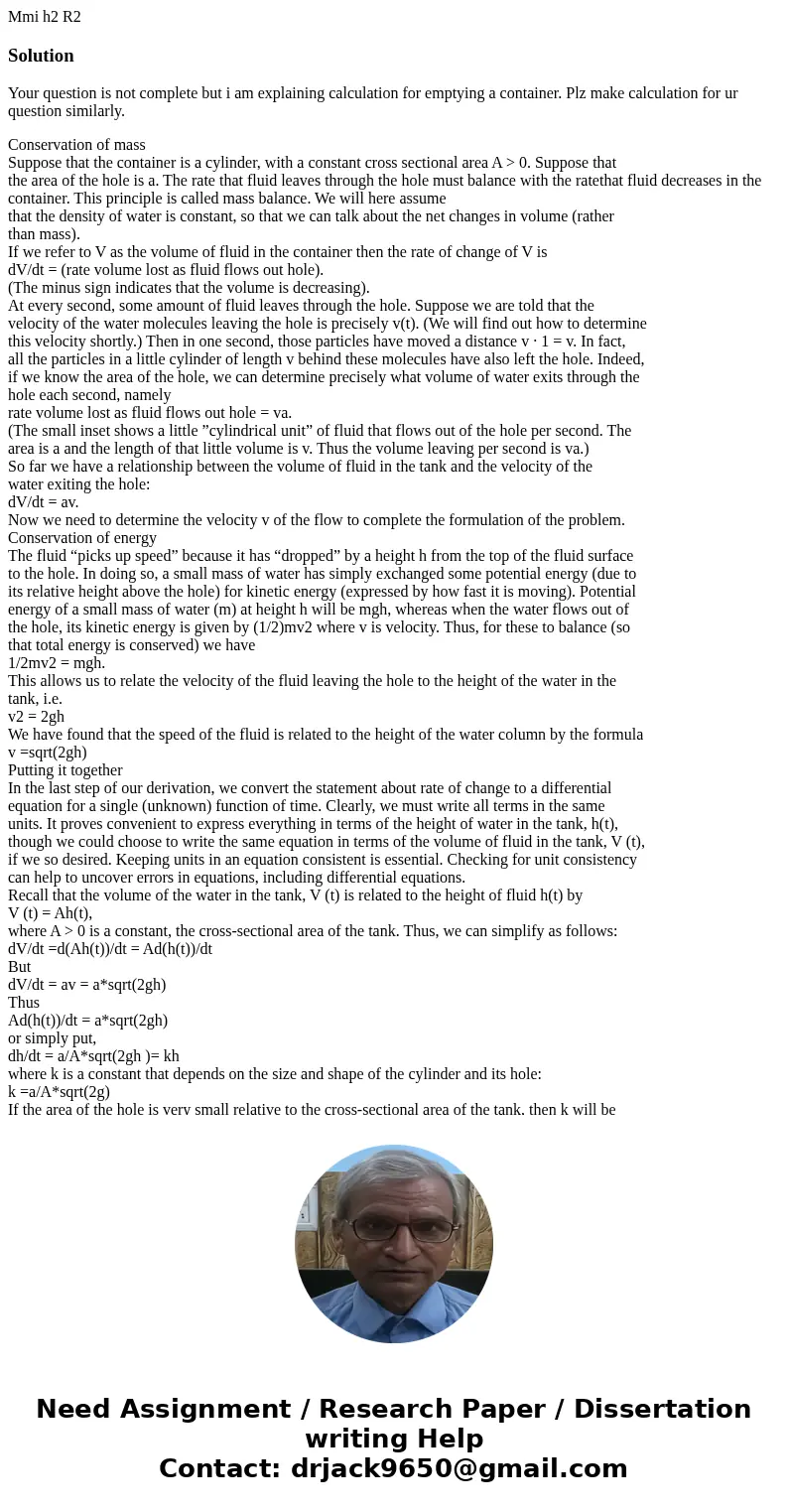Mmi h2 R2 SolutionYour question is not complete but i am exp
Solution
Your question is not complete but i am explaining calculation for emptying a container. Plz make calculation for ur question similarly.
Conservation of mass
Suppose that the container is a cylinder, with a constant cross sectional area A > 0. Suppose that
the area of the hole is a. The rate that fluid leaves through the hole must balance with the ratethat fluid decreases in the container. This principle is called mass balance. We will here assume
that the density of water is constant, so that we can talk about the net changes in volume (rather
than mass).
If we refer to V as the volume of fluid in the container then the rate of change of V is
dV/dt = (rate volume lost as fluid flows out hole).
(The minus sign indicates that the volume is decreasing).
At every second, some amount of fluid leaves through the hole. Suppose we are told that the
velocity of the water molecules leaving the hole is precisely v(t). (We will find out how to determine
this velocity shortly.) Then in one second, those particles have moved a distance v · 1 = v. In fact,
all the particles in a little cylinder of length v behind these molecules have also left the hole. Indeed,
if we know the area of the hole, we can determine precisely what volume of water exits through the
hole each second, namely
rate volume lost as fluid flows out hole = va.
(The small inset shows a little ”cylindrical unit” of fluid that flows out of the hole per second. The
area is a and the length of that little volume is v. Thus the volume leaving per second is va.)
So far we have a relationship between the volume of fluid in the tank and the velocity of the
water exiting the hole:
dV/dt = av.
Now we need to determine the velocity v of the flow to complete the formulation of the problem.
Conservation of energy
The fluid “picks up speed” because it has “dropped” by a height h from the top of the fluid surface
to the hole. In doing so, a small mass of water has simply exchanged some potential energy (due to
its relative height above the hole) for kinetic energy (expressed by how fast it is moving). Potential
energy of a small mass of water (m) at height h will be mgh, whereas when the water flows out of
the hole, its kinetic energy is given by (1/2)mv2 where v is velocity. Thus, for these to balance (so
that total energy is conserved) we have
1/2mv2 = mgh.
This allows us to relate the velocity of the fluid leaving the hole to the height of the water in the
tank, i.e.
v2 = 2gh
We have found that the speed of the fluid is related to the height of the water column by the formula
v =sqrt(2gh)
Putting it together
In the last step of our derivation, we convert the statement about rate of change to a differential
equation for a single (unknown) function of time. Clearly, we must write all terms in the same
units. It proves convenient to express everything in terms of the height of water in the tank, h(t),
though we could choose to write the same equation in terms of the volume of fluid in the tank, V (t),
if we so desired. Keeping units in an equation consistent is essential. Checking for unit consistency
can help to uncover errors in equations, including differential equations.
Recall that the volume of the water in the tank, V (t) is related to the height of fluid h(t) by
V (t) = Ah(t),
where A > 0 is a constant, the cross-sectional area of the tank. Thus, we can simplify as follows:
dV/dt =d(Ah(t))/dt = Ad(h(t))/dt
But
dV/dt = av = a*sqrt(2gh)
Thus
Ad(h(t))/dt = a*sqrt(2gh)
or simply put,
dh/dt = a/A*sqrt(2gh )= kh
where k is a constant that depends on the size and shape of the cylinder and its hole:
k =a/A*sqrt(2g)
If the area of the hole is very small relative to the cross-sectional area of the tank, then k will be
very small, so that the tank will drain very slowly (i.e. the rate of change in h per unit time will not
be large). On a planet with a very high gravitational force, the same tank will drain more quickly.
Using the above physical argument which combined simple principles such as conservation of
mass and conservation of energy, we have shown that the height h(t) of water in the tank at time t
satisfies the following differential equation:
dh/dt = k*sqrt(h)
Clearly, this equation is valid only for h non-negative.


 Homework Sourse
Homework Sourse